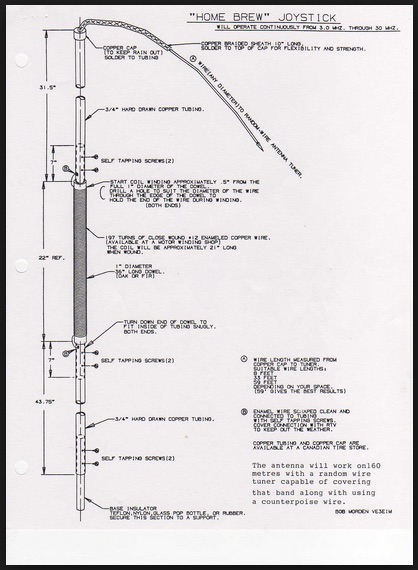Over the years every ham has read the advertisements about the various incantations of various types of vertical antennas. “Pick me, pick me, pick me” they all shout. And of course they are backed up with the usual testimonials. Published gain figures are dubious as they are often compared with antennas we have never heard of at locations that don’t exist. Of course we can always search eHam reviews to get a better idea of what any given antenna is like. Even after you have done your research and made your purchase, your results will vary as your soil will be different, your height above ground, whether or not you have used radials and the list goes on. The other variable that cannot be underestimated is the skill of the op. A really good op using a poor antenna will usually outperform an unskilled op using a great antenna. Indeed – mileage does vary.
One local trader on our main NZ trading site is currently listing OCF (Off Centre fed) Windom antennas and making outrageous claims in his advertising pitch to get you to buy his antenna. The vendor suggests that we look up K4(Callsign withheld). I have just researched the DXCC lists and he appears NOWHERE on any recognized DXCC or CQ listings in any mode. If the antenna works as well as he says it does, he would have the plaque on the wall. Surprise, surprise. “Work 200 countries in a weekend” sounds good when you read the advertising copy. It would be foolish to believe that the antenna would do it for you.
At the end of the day, the OCF antenna actually does work OK but uses a bit of jiggery pokery to the lengths of each side and a few well placed ferrite cores to make you think that it is more than a dipole. It isn’t a dipole as we all know! It is a dipole of suspect parentage.
Advertising is advertising. Claims are claims. Our trader is using the same techniques that the purveyors of women’s anti-wrinkle cream use. It is the same language that Proctor & Gamble have used since the last century to sell toothpaste, which after all is simply cream and a bit of abrasive that makes you feel good when you blind the women you are chatting up in the pub. And visa versa.
Over selling radio antennas is the not the sole domain of our trader. Gotham Antennas in the USA sold untold 23′ lengths of aluminium in the 1950s. Man, you were nowhere until you had a Gotham vertical. “Work the world with a Gotham vertical” was the slogan And did it work; just ask the man who owns one. (It did, after a fashion if your put attached radials and mounted it above the garage roof and used an antenna coupler. Sorry, you don’t get that info in the ad!!)

Original Gotham Advertisment in the 1950s
The USA was not the only country that they had the ultra compact answer to the 4 el full size yagi. The Partridge Manufacturing Company in England marketed a 6′ tube wound with wire indoors in the corner of the shack that they said would outperform anything. And of course the testimonials where there on the page to backup their claims. And of course, thousands of hams around the world bought the “Joystick” but there wasn’t much joy after you paid over your money. Just a pain in your bank account.

A home brew version of the “Joystick”

An original “Joystick”
So the cry is “lynch the trader, hang em high and bring out the Fair Trade Act”. Being drawn and quartered at least would satisfy our thirst for blood.
Is this going to stop the vendor from printing his advertising crap? I doubt it. What will stop this sort of thing is every club that has newcomers to the hobby making sure that the vendor’s products and claims are well known at club level. Clubs and locals have contacts with most new amateurs and can do that. It comes back to what I mentioned a few months ago about mentoring the newcomers, getting close to them, advising them that antennas can be made that will work well for a fraction of the price.
What I am saying here is to look at the adds, do your research and the ask around in your amateur community for opinions and what they use. It wont be long before you will realize that you don’t get something for nothing in this antenna business. Gain is hard won by plenty of resonant wire or alloy up very high and rotatable.
Complaining about rogue traders in the ham section of eBay or Trade-me and burying your head in the sand with newcomers is not smart which is why these traders survive. They may not get a lot of repeat sales, but he survives. I won’t discuss pricing, as that is a whole new can of worms that I have no intention of opening except to say that every trader must make and is entitled to a profit to stay in business either on turnover or markup. Oil companies do it on turnover and jewellers do it on markup.
At the end of the day… it is and always has been Caveat Emptor. As experienced capable amateurs, we can mentor newcomers and cut down on this sort of trading abuse.
DX IS!
73, Lee ZL2AL





